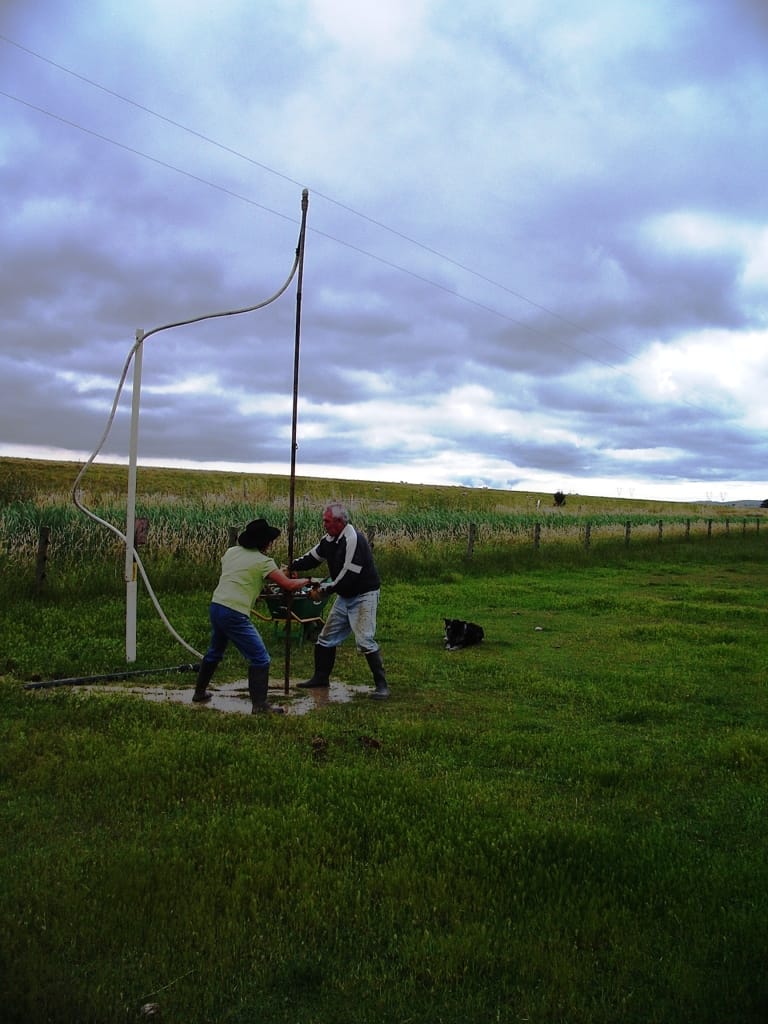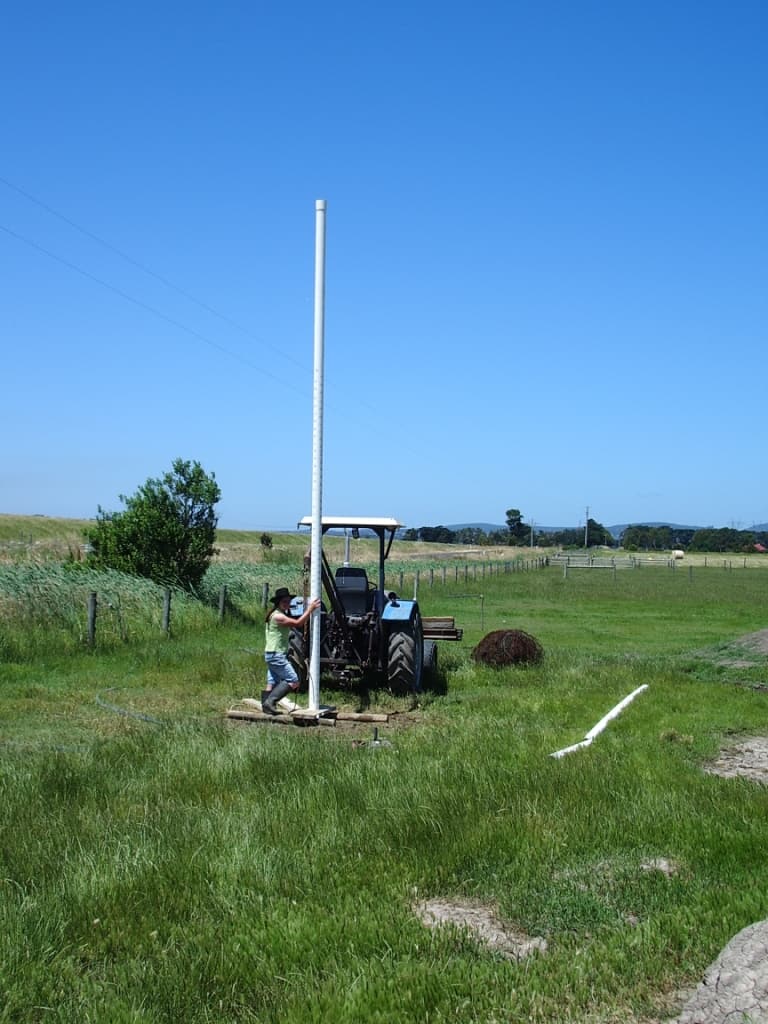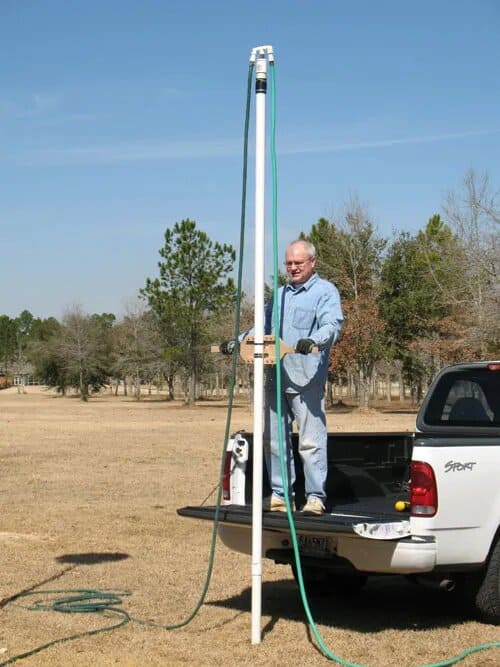This hand made cutter has successfully hand drilled many hundreds of metres of water wells. For example, on our Hazelwood flats farm we drilled 10 of 25 metre deep 100mm diameter bores which collectively provided enough water to irrigate 50 acres ie66 megalitres (660 million litres) of water annually.
Compare that to your ‘normal’ domestic consumption. My wife Della and myself I were able to hand drill these by ourselves with only the aid of a fire pump.
Here you can see Della and a friend drilling one of the wells:

And here Della is pushing a 6 metre length of slotted pressure pipe down to case the well (4 per well).

In Victoria no permit or licence is required for a bore of 3 metres depth. It is surprising how many places will produce useful amounts of water at that depth. Try the dry bottom of your nearest gully for a start, or any dampish patch on your block. If you are only watering a vegie garden and home orchard (and not many acres of pasture) it is likely that a small number of such low producing bores will suffice.
You can spend the money acquiring a bore and a water licence if you want to go deeper (as we did at Hazelwood and elsewhere, eg here at Jeeralang Junction) . The bore permit is all you will need if your needs are ‘stock and domestic’ which will allow you to water the above plus 3 acres for fire prevention purposes!
We went 25 metres at Hazelwood as the deeper aquifers were already allocated (but this shallower one was not, so we were able to acquire a licence for it). Some of those bores flowed 2-4 litres per second! We were able to employ the services of someone who had a hand drilling licence to supervise and certify the bores which were then inspected, passed and licensed by the appropriate authority. Southern Rural Water will ave a list of folks in your area who have driller’s licences.
A well-point system of say 10 such bores linked underground by a powerful suction pump, each bore’s production controlled by a check valve can water a large area – in this case 50 acres! We could have extracted even more. Even ¼ litre per second of flow (pumped/siphoned 24/7 will produce enough to run a (1L/sec) pump for 6 hours per day over the summer. If you have a secure storage dam which can be filled from it (perhaps you will need to line it) , you can do even better.
Even a small spring can be ‘proved’ to produce significant water. A friend of mine has trenched an approx 30 metre per side ‘V’ below such a spring on his hillside, lined it with gravel and agricultural drainage pipe carrying the water to a sump which he pumps into a 20,000 litre tank to irrigate his garden. Unbelievably this small damp patch on his hillside is producing between 1-2 litres per second – easily enough to keep his allowed 3+ acres green.
The largest (gold) fish farm in Australia (at nearby Boolarra) exists because of the owners’ ability to capture and re-use (over and over) the production of one really good spring in one small valley (approx 2 km long!)
Here’s how to do it: This is a 1” plumbing fitting (photo). You need to make several sections (depending on the depth you want to go) of 1” gal water pipe threaded both ends. 2 metre lengths are good. You will need a number of barrel unions to join them as you go deeper. At the top you will need a (water-tight) swivel to direct the fire pump’s jet down the tube.
The water needed can be ‘trucked’/trailered to site in one of those 1 square metre ‘cubes’ you see everywhere as we have done. You need a couple of pipe vices bolted to approx 75 cm lengths of ¾’ RHS so you can turn the pipe and cutter (clockwise) whilst the water is flowing.
The water will soften the bottom and wash the cuttings out the top. Dig a bit of a drain to allow the water to escape or you will always be working with wet feet (The water can be recaptured in a small pond lined with plastic sheeting).
Gravel makes the going more difficult (but it is just such coarser materials where water flow is best). Stones will almost certainly stop you. Choose another hole (or a different cutter). Sometimes a stone can/will be forced into the softened wall on the side of the hole, so persist a while.
You can hear/feel the nature of the material you are going through. Also the colour of the water and the material you are digging through will reveal itself in the water you are washing out of the hole. Sand is good. You will be astonished just how much water will flow through a couple of feet of sand at 10’ depth.
I suggest drilling a 6” pipe for a 4” casing. Plastic pressure pipe is best (as it will withstand compressed air needed to clean the well in order to complete it). You can slot it with a stone blade on a 4” angle grinder. The pipe comes in 6 metre lengths. It might be easier to use 3 metre lengths and glue them together with joiners.
A chap I know used thin-walled pre-slotted 90 mm drainage pipe to construct a well-point system which irrigated many acres, but there is a greater danger of the pipe collapsing. It hasn’t after 30+ years! 90 mm pipe will probably require a hole (cutter) of approx 120 mm. You will find it much harder to buy a submersible (or other) pump to fit down a 90mm pipe, but a foot valve is no problem. You can even fit a 2″ foot valve down a 65 mm pressure pipe maybe making this an ideal size for the hobbiest.
You can construct a tripod and pulley system to lift out the sections of pipe if you are going very deep. Be sure not to drop things down the hole. Monkey wrenches are notorious for their ability to find their way down wells. Tie them to a steel post with some stout string (likewise anything else you are likely to drop down the hole). I know this from experience! It is unpleasant to have to abandon a half-dug well because of some object you have dropped down it and are unable to ‘fish’ out. You can spend many fruitless hours of such ‘fishing’.
Likewise you can construct a wooden clamp out of eg 150mm x 50mm treated pine boards to hold the slotted pipe as you lower/force it into the well. It is useful to cut teeth on the bottom of the pipe so that as you turn it it cuts its way down. The best water bearing material will tend to collapse preventing the pipe from going down. If it sticks, compressed air/water may clean the bore to allow its passage as you case the well.
You will need the compressed air (250+ cu ft/sec) to clean and ‘prove’ the well anyway. You can ‘concentrate ‘ the water/air for such (bottom) by slipping a 90mm pipe inside your 100 mm pipe with caps both ends one allowing water in (top) the other (bottom) allowing water to jet out will move the obstructing material up the 100 mm pipe so that it will go down to the bottom.
When it is in place you need to seal the bottom by drooping a plastic bag of mortar mix down it, then breaking the plastic bag with your steel pipe so it will set. When it is set you can use compressed air to ‘prove’ the well. Washing it out with compressed air will jet water containing fines high in the air (you will need a raincoat) and move coarser material nearer your slots. It is a washing machine sort of action. You surge the material out, let the bore refill then surge it out again.
You can do this for say half an hour. You need a pretty big compressor to do this well, say over 250 cuft/sec. Finer horizontal slots (lots of them) are best. Water flows best through coarse material. I have seen a hand dug bore like this flow 9 litres per second. That would be enough to irrigate several acres!
The method set out in the link below also works really well for very small diameter wells in sandy material. You can drill using your garden hose! A 3/4 “ hose will deliver lots more water though. I guess you could rig your Guerney up to it to really cut through tough material like clay. It is ridiculously inexpensive. All pipe fittings available at Reece’s or Bunnings (50 mm and 32 mm pressure pipe – but cheaper elsewhere!).
Installing eg a 50mm barrel union ‘cutter’ to the bottom works even better. You can go down 3 metres in a few minutes and install a 32mm slotted suction pipe. If you are using a fire pump it really scoots down. This would work really well in many bayside locations where the ground is mainly sand and the water is quite close to the surface.
The limit to how ‘high’ a pump will suck is 7 metres but it will suck very little deeper than 5 metres. If you suspect there may be water in your back yard this may be worth a try. Be sure to check where utility cables/pipes are first before you drill. If you are only using plastic ‘teeth’ on your 2’ pipe it should not cut through them, but best to find out where they are anyway.
Now (when there is no drought) would be a good time to drill in preparation for water restrictions in the future, but anyway utility water is so expensive particularly if you have a larger garden. Be sure to get your water EC (electroconductivity) checked before watering the garden with it. Very salty water can harm your plants (eg http://www.dpi.nsw.gov.au/agriculture/resources/soils/salinity/crops/saline-irrigation) By the same token you can use much saltier water in higher rainfall areas or where the soil is quite sandy.
This is a great link: ‘How To Drill Your Own Water Well’: http://www.drillyourownwell.com/index.htm It teaches you how to drill your own well with just PVC fittings and a garden hose – and it works! I have tried it.

Some other ideas here. Happy drilling:
Drive your own freshwater well by Len McDougall
http://www.backwoodshome.com/articles2/mcdougall128.html
http://wayback.archive.org/web/20080107184220/http://www.drillingfab.com/
‘Portable Water Well Drilling Rigs new or used, DIY books and manuals. We sell Portable water well drilling rigs plus well drilling troubleshooting books. Our best selling book is water well drilling rig plans.Complete guide to build your own drilling rig. For rock or compact soils.’
If you want to do some serious drilling you can buy rigs quite cheaply on Aliexpress. (This may require a licence depending on your location.
First Published Feb 6, 2016



Thanks for all the detailed ideas. I liked the clever way you used the pulley system and a tripod.
Thank you Pete. Good luck with your own projects.
If you drill greater than 3 mts you need a bore construction permit and you also need to have the work carried out by a liscenced driller. Failure to do so will leave you open to prosecution and large fines, plus your “bore” will have to be decomissioned, ie have the casing removed and the hole filled to the surface with cement, at the owners expense….this work can only be carried out by a liscenced driller. There is a very real risk of polluting an aquifer if the work is not carried out correctly.
Thank you Dan. I covered that in the post. Of course there are many other places where such silly rules do not exist. I have readers from all around the world. Someone new arrives every minute! 1200 posts yet you managed to find one to criticise! Cheers, Steve.
It is good to know that you can use a pulley system and a tripod to help you make the hand drilling process a lot easier. I want to get a water well made sometime soon. It might be better for me to hire a professional to drill the well for me.
I never knew that in most places you don’t need a permit to drill for water past 3 meters! I was thinking about doing it myself, but now that I think about it, a professional might save me a lot of time. Thanks for the tips, if I do decide to do it myself I’ll know where to go.
Thanks Luke. That’s to 3 metres. If you have soft soil and a high water table you will find the pressure water method very quick and easy. Cheers, Steve.
Hi there
You have updated Very unique and useful article, that contains good stuffs. I am sure it might be helpful for all visitors.
Thank you so much for sharing.
For more deatils visit:
http://sicsupergroup.com/